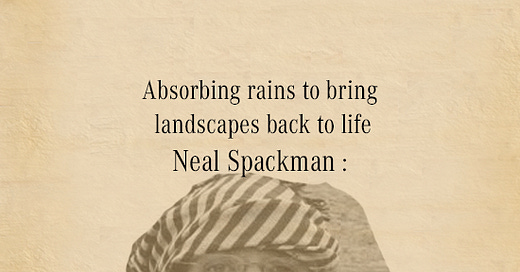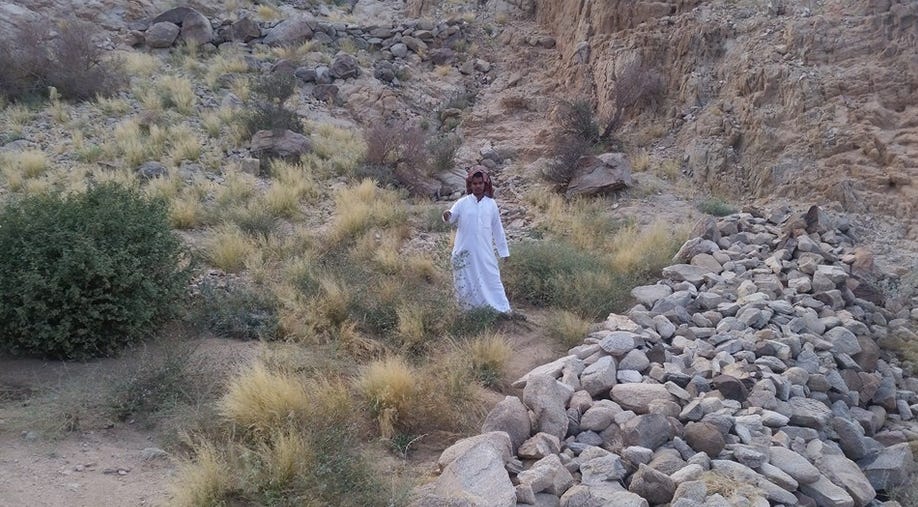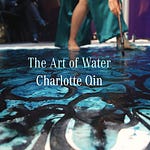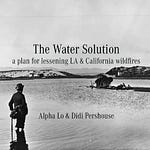Trees, stout and rugged, once dotted the valleys in the Makkah province in Saudia Arabia. An indigenous system of community land management called Hima allowed nature to flourish for thousands of years. But then in 1950s Hima was abolished, and desertification set in. People cut down trees, so they could have money to import food for their animals.
The land became austere. The sun seared desolation into the hills and wabis (the valleys). The earth became dry as a parched throat. Xerophytic plants baked in temperatures that reached 50 degrees Celsius (122 Fahrenheit). Animals were rare, except for the resourceful camels that weave their way through the landscape.
[Al Baydha, from the “The story of Al Baydha - A regenerative agriculture in the desert” video]
This is the land Neal Spackman came to help restore.
One of the keys to restoration was to capture the rare rains, the rains that came once a year, or sometimes even less. These rare rains would turn into angry floods that left deep scars in the landscape. The important step was to turn these watery forces of devastation into a force of regeneration. He worked with the community to pile rocks into gabions and check dams, to slow the flow of the waters, then created initial plant beds to absorb the rain.
Over the course of many years the vegetation came back, with the growth of plants like zizyphus, acacia, and sesbania seban. Biodiversity returned.
I had the honor of having a dialog with Neal Spackman in this podcast episode. He is coming with us as we return to Iberia, to look at how to restore the water cycles and the rain there.
This is the fifth article/podcast in a series that has a connection to restoring the Iberian water cycle and rain : 1. “Restoring Iberian rain” 2. “What implementing agroforestry on farms would do to the rain : a European perspective” 3. “How eco-tourism can help the regenerative water movement : Anna Pollock interview” 4. Regenerating a farm and a semi-arid region: Silvia Quarta.
Global warming causes the air to be able to hold more water like a sponge, which means droughts are longer. But then when the sponge wrings out, we are beset with bigger storms.
This week the eastern and southern coasts of Spain were pounded by huge rains. In Valencia, which was hit the hardest, rivers of mud devastated the city. Unfortunately many died. A landscape of buildings were destroyed. The road to recovery will be a long one.
Preparations can be made for future large rains. We can work to restore the land, so it can absorb more of the rain, so that it can lessen the amount of that water that reaches cities downslope of it. Floods will then be a lot smaller.
Just like in Saudia Arabia, the power of devastation can be turned into the power of regeneration. If there is vegetation, soil, and earthworks to slow and spread the stormwaters upslope, then more of the water can then sink into the land to refill the aquifers. That groundwater can then be brought up by trees in the dry season to hydrate the environment, and to evapotranspire to increase the small water cycle, and bring back summer rains. Nature can dampen the wild variability of our climate - lessening the impact of the big rains in the wet season, and increasing the rains in the dry season. Spain’s future food systems are being threatened by the droughts in regions like Valencia and Andalusia. Nature can store and dampen the big wet season rains, to help create summer rains that aid agriculture.
……..
Here is part of the podcast dialog between Neal and I, recorded before the floods hit. Neal talks about his ecorestoration work in Saudia Arabia, and proposes some ideas for water related eco-restoration in Andalusia, Spain. (Dialog edited for brevity, grammar and clarity).
Alpha: Do you want to share a little bit about how you got into the whole regenerative sphere and your background?
Neal: I spent two years in Guatemala in my early 20s, and while I was there, I became very interested in sustainability in food systems and in the built environment. I met a group of corn farmers whose farms had failed. They were forced to leave everything behind and move to the city, hoping to find a better life for their kids. That sparked a question for me: why does a corn farm fail in Central America? What’s really going on?
I grew up thinking I'd be a doctor like my dad, who was a cardiac anesthesiologist. But I became deeply interested in sustainability—specifically in food systems, building materials, and all that. At that time, I didn’t think I could make a living out of it, so I majored in Middle East Studies, Arabic, and did some economics work in undergrad.
Then, all those interests converged when I was offered a co-founding role at the Al Baydha Project in Saudi Arabia. Back then, we thought of it as building a “green village,” and it evolved in many directions. Al Baydha was funded by Her Royal Highness Princess Haifa Al-Faisal, the youngest daughter of the late King Faisal, and for her, it was a humanitarian effort. We were working with settled nomadic tribes south of Mecca, and the project encompassed a wide range of community development—education, infrastructure, and more. My role was focused on the land, water, and economy side, working with people to bring life back to degraded landscapes in ways that could restore nature and allow people to make a living off their land again.
Al Baydha is about a 45-minute drive south of Mecca, in the foothills of the mountains, where we averaged around 60 millimeters [2.3 inches] of rain a year. It’s minimal. And that's an average, but in deserts, averages don’t count for much. You might go two years with no rain, and then in the third year, get six inches over a couple of events. So you’d have 24 hours of rain spread across a thousand days. It’s an extremely austere landscape. And that’s part of what made it meaningful—we were working in conditions many thought impossible, yet proved restoration was achievable. What resonates with people about Al Baydha is the way we approached it—holistically, and under such harsh circumstances.
Alpha: What kind of background did they hire you for?
Neal: I already had experience living in the Middle East, knew the language, and understood the culture. I also had the theoretical knowledge about land restoration, but no hands-on practice. I think they wisely chose someone with social and cultural skills over technical land skills, because I believe the socio-political and economic aspects are actually more challenging than the land itself. Once you get that right, nature has a way of filling in the rest. The complexity is really in working with people, not with nature, which is fairly straightforward once you're moving in the right direction.
Alpha: And where did you get your theoretical background from?
Neal: I’d done some permaculture, including a Permaculture Design Certificate course, and read a lot about traditional systems—Nabataean water management, Incan water systems, agroforestry practices in the Negev Desert, and similar topics. I was passionate about polycultural, agroforestry, and agroecological systems, including silvopasture. In the project, we ran hundreds of small experiments to see what worked, building on tiny successes.
Alpha: What were some of the main techniques you used to restore the land and water?
Neal: We focused on what’s called “natural” or “green infrastructure.” We experimented with gabions, check dams, one-rock dams, zuni bowls, zai holes, fish scale berms, and basins. These small earthworks intercepted water flow in different parts of the landscape. We also constructed about four kilometers of swales, both on and off contour, some based on keyline design. These helped us manage water across the dry river valleys and floodplains.
[check dams made of rock to slow the waters. From “The story of Al Baydha” video]
Alpha: So you essentially slowed the water down and gathered it, right?
Neal: Yes, exactly. In that environment, we didn’t have sticks to use, just rocks and dust. By placing structures on or off the contour, we managed how water flowed across the land. Geoff Lawton, an early consultant, helped guide us, and I also trained in aquaponics and took courses with people like Darren Doherty on keyline design. We didn’t adopt every recommendation, but these early steps got us moving in the right direction.
Alpha: After managing the water, did you start building soil or planting?
Neal: We manually planted trees, trialing about a dozen species—half native, half non-native—to create microclimates, provide economic outputs, and withstand the climate. A key goal was silvopasture because the local culture is still pastoral. We needed to grow trees that could feed camels, sheep, and goats, which were central to the community’s identity and livelihood. So, silvopasture was really our end goal, and ideally, we’d also develop a high-value crop to sell in export markets. Silvopasture means tree-based grazing systems, a traditional agroforestry practice. Historically, in that climate, there was enough rainfall for a summer and winter growth cycle. Rain would trigger a brief growth of annual grasses that would seed and die off quickly, allowing grazing for a few months. Then, during dry months, people would rely on trees for grazing. This cycle sustained camel herding, with the Hima system managing land fertility and productivity. Our project aimed to restore something like that, supplementing it with potential tree-based cash crops.
Alpha: You mentioned the social side was even more challenging. What were some of those difficulties?
Neal: Building trust was crucial. Our vision was to empower the community to sustain these systems long-term. We needed them to know we weren’t there to exploit them but to work with their traditional ecological knowledge. Building trust takes time and showing that we were trustworthy.
Secondly, it was about understanding how our ecological goals fit with their practices, ensuring we weren’t imposing something foreign but collaborating. Revitalizing rather than restoring their economy was key, respecting the socio-political and economic realities they lived in.
Alpha: What were the ecological results of the project?
Neal: I published an article on LinkedIn last year showing satellite data on the site’s NDVI (Normalized Difference Vegetation Index), which tracks photosynthesis. Before we began, there was little response to rainfall. Now, the land’s response to rain has drastically improved. Even though we stopped active work in 2016, it’s getting greener each year, which shows we pushed the ecosystem to a more productive state. This year, it’ll likely stabilize at a new level, where rainwater more effectively drives biological activity.
[vegetation grows back in Al Baydha]
While working there, we saw life come back in stages. First, fungi and plants appeared, followed by insects, birds, and small mammals, eventually leading to the return of predators. It was deeply fulfilling to witness life coming back to a once-dead landscape.
Alpha: Did you inoculate the soil with mycelia initially?
Neal: No, we didn’t. We added no inputs—no compost, no mycelia, nothing like that—because it was too costly. We only focused on water management and manual planting. One interesting experiment involved composting a camel carcass, which I did to teach my team about biodegradation, which is very slow in such a dry environment. Without interventions, organic material doesn’t break down naturally there. It was part of understanding that fixing the water and mineral cycles was essential for ecological rehabilitation.
Alpha: So, you focused on water, planted some trees, and let nature take over?
Neal: Exactly. We gave the ecosystem enough of a push, and then nature started filling in the gaps. It’s an accelerating cascade. When I returned in 2020, after two and a half years without rain, the land was lush compared to how we left it. While it’ll never be a rainforest, it’s reached a state where a wet season brings vibrant growth. Native species have even started regenerating on their own.
Alpha: So, by setting it in motion, you created a self-sustaining system.
Neal: Yes, we gave it the push, and now nature is re-colonizing the area. Watching it unfold and seeing biodiversity increase has been incredibly rewarding. It's deeply satisfying to help bring life back to a barren place. We saw the fungi come back first, and then plants and insects started reappearing. Then birds and lizards returned, and eventually mammals. Within four or five years, we even had predators on the site. When we first started, there weren't even ants. It actually took three years for ants to show up.
Alpha: Wow. And you didn’t notice them until they were right there?
Neal: Exactly. The first time I saw them, I was like, “Wait, there are ants here!” Then I realized their absence had gone unnoticed until that moment. They’re so ubiquitous—they should be everywhere. But they weren't on our land until three years in. It’s hard to describe, but bringing life back to a place that felt dead is an incredibly satisfying, even sublime, experience.
Alpha: So, it’s like you set up the water system, plant a few things, and then nature takes over, right? Once it’s over that initial hump, the vegetation attracts more wildlife, and you’ve started a rewilding process that can sustain itself.
Neal: That’s right. We gave it enough of a push that nature said, “Okay, let’s re-colonize this place.” And the speed of the cascade only increased from there. In 2020, I returned to capture the “after” footage for a project. I’d been away for two and a half years, during which there’d been almost no rain. Some of the trialed trees didn’t survive without irrigation, but we had cut the water on purpose to see which species could adapt to the ecosystem naturally.
When I got back, the once dusty, rocky landscape had transformed into this amazingly lush green space. Now, it’s not a rainforest, and it never will be, but it’s developed into an area with a defined wet and dry season. When it rains, it’s truly green, with native ground covers and trees starting to grow on their own.
Alpha: I wanted to ask your thoughts on regenerative practices in places like Spain and Portugal.
Neal: My experience in Iberia is mostly in the south, around Cádiz. The dehesa and montado systems—the traditional cork oak agroforestry—are stunning. They create this beautiful, self-sustaining landscape that produces delicious food. Iberia is also sparsely populated, with large areas where agriculture has been a way of life for centuries.
For example, I know about a cooperative of rice farmers near Sevilla, along the Guadalquivir River. The river’s tidal influence now pushes saltwater over 100 kilometers inland, affecting freshwater irrigation and decimating farm productivity. These farmers are struggling to adapt to the high salinity and water shortages, often leaving fields fallow.
Alpha: So what’s the solution? Do you have suggestions for these rice farmers?
Neal: They could explore salt marsh agroecology. I’ve collaborated with Seawater Solutions, which works on marshland restoration and promoting halophytic (salt-loving) crops. There are plants like salicornia, also known as sea asparagus, that can grow in saltwater. Halophytes are especially promising for regions with soil salinization challenges.
Alpha: So you’re saying they could switch from rice to these halophyte crops?
Neal: Yes. Growing rice is likely no longer viable for them, but there are many salt-tolerant crops they could farm profitably. Salicornia, for instance, has been eaten for centuries, and Distichlis—a salt-tolerant grain—also has potential. Halophyte farming is still a young industry, but it could be transformative for coastal areas dealing with salinization and water scarcity.
Alpha: And restoring these coastal marshes could also improve local water cycles?
Neal: Absolutely. Coastal areas often suffer from disrupted small water cycles due to degraded ecosystems, like drained mangroves or marshlands. Restoring these areas, whether for agroecology or conservation, can significantly influence local evapotranspiration and, potentially, rainfall patterns. It’s my opinion, though unproven, that coastal rehabilitation is crucial to restoring small water cycles, especially in places like the Iberian Peninsula.
Alpha: I agree. There’s a study by Millan Millan suggesting coastal marshes cool and humidify incoming sea breezes, which could lead to rain further inland. Restoring these areas could be essential in southern Spain, where many marshes have been drained.
Neal: Precisely. With partners, including Carl Hodges, a pioneer in saltwater agriculture, I’m working on scalable projects focusing on mangrove-based agroecology for tropical regions, like Mexico and Texas. But in places like the Mediterranean, a marsh-based agroecology might be more appropriate, delivering both economic and ecological benefits.
In Cádiz, near Donana National Park, marsh restoration would be instrumental. Donana is a critical wetland that's been drying up, and restoring it could bring both biodiversity and water cycle resilience back to the area.
Coastal ecosystems are absolutely critical, in my opinion. Once you move uphill from them, you start to see the interplay of deforestation, desertification, and drought-flood cycles. If you have forested hillsides, when it rains, there’s minimal erosion, and the landscape can capture and slow down that water. But if you deforest those hillsides for agriculture—as the Romans did in Italy—you end up with drought-flood cycles. You might get the same amount of rain initially, but the biological structures that manage that rainfall are gone. This results in massive soil erosion and destructive floods because the land can't absorb and utilize the rain, which we refer to as ineffective rainfall.
When we plow, deforest, and convert land to agriculture—and then keep plowing year after year—you lose the ecosystem’s ability to retain and make use of water. Parts of Iberia, for example, have been farmed for about 1,600 years continuously. As a result, these ecosystems lose their function, and drought-flood cycles inevitably follow deforestation. I don’t know of any exceptions to that rule. This means that rainfall becomes more intermittent and less reliable, and when it does come, it can’t be captured effectively, so it becomes destructive.
We see this pattern in desert cities all the time. For instance, Mecca floods every time it rains, despite the governorate spending billions on flood management systems. However, these systems simply shunt water into the sea as quickly as possible. You see the same approach in Los Angeles—the LA River used to function as a natural system, but now the flood management system diverts water into the ocean as quickly as possible, without a design to use that water for supporting life on the land.
So the approach becomes, ‘Get rid of the freshwater as quickly as possible to reduce infrastructure damage.’ But in doing so, we’ve also removed the land’s ability to support life by disposing of the freshwater that comes.
……….
This is a reader supported, hydro-friendly, organically emergent, newsletter/podcast
















Share this post